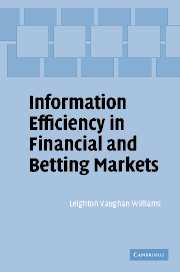Book contents
- Frontmatter
- Contents
- List of figures
- List of tables
- List of contributors
- Introduction
- Part I The concept of information efficiency
- Part II Selected readings
- 4 An assessment of quasi-arbitrage opportunities in two fixed-odds horse-race betting markets
- 5 The presence of favourites and biases in bookmakers' odds
- 6 Searching for semi-strong form inefficiency in the UK racetrack betting market
- 7 Models, markets, polls and pundits: a case study of information efficiency
- 8 Longshot bias: insights from the betting market on men's professional tennis
- 9 Biases and insider trading in exotic bets on thoroughbreds
- 10 On the improbability of information efficient parimutuel betting markets in the presence of heterogeneous beliefs
- 11 Modelling gambling demand in a laboratory casino: discovering the importance of individual-specific effects
- 12 Market efficiency of the 50–30–20–10 horse-racing spread betting market
- 13 Insider trading and bias in a market for state-contingent claims
- 14 Rationality and efficiency in lotto games
- 15 Efficiency of the odds on English professional football matches
- 16 Modelling distance preference in flat racing via average velocity
- 17 Testing for market efficiency in gambling markets: some observations and new statistical tests based on a bootstrap method
- 18 Information (in)efficiency in prediction markets
- Index
- References
8 - Longshot bias: insights from the betting market on men's professional tennis
Published online by Cambridge University Press: 09 July 2009
- Frontmatter
- Contents
- List of figures
- List of tables
- List of contributors
- Introduction
- Part I The concept of information efficiency
- Part II Selected readings
- 4 An assessment of quasi-arbitrage opportunities in two fixed-odds horse-race betting markets
- 5 The presence of favourites and biases in bookmakers' odds
- 6 Searching for semi-strong form inefficiency in the UK racetrack betting market
- 7 Models, markets, polls and pundits: a case study of information efficiency
- 8 Longshot bias: insights from the betting market on men's professional tennis
- 9 Biases and insider trading in exotic bets on thoroughbreds
- 10 On the improbability of information efficient parimutuel betting markets in the presence of heterogeneous beliefs
- 11 Modelling gambling demand in a laboratory casino: discovering the importance of individual-specific effects
- 12 Market efficiency of the 50–30–20–10 horse-racing spread betting market
- 13 Insider trading and bias in a market for state-contingent claims
- 14 Rationality and efficiency in lotto games
- 15 Efficiency of the odds on English professional football matches
- 16 Modelling distance preference in flat racing via average velocity
- 17 Testing for market efficiency in gambling markets: some observations and new statistical tests based on a bootstrap method
- 18 Information (in)efficiency in prediction markets
- Index
- References
Summary
Motivation
The best known stylised fact to emerge from the area of research reflected in this volume is that, in horse and dog betting, financially superior returns (i.e. smaller losses) accrue to a strategy of wagering on short-odds rather than long-odds runners. This bias is sufficiently pronounced that expected returns may even be positive where one bets only on extreme favourites. The evidence for the existence of this bias in the odds dimension is impressively voluminous and has accumulated over more than five decades.
The existence and persistence of such ‘longshot bias’ represents an anomaly when viewed within the tradition of treating wagering markets as examples of financial markets. According to the efficient markets hypothesis, prices (odds) should reflect all available information relevant to the outcome of a race. With all agents risk-neutral, expected returns, in equilibrium, would then be the same for all possible bets and so invariant with respect to odds. Further, it is more common in economics to assume risk aversion rather than risk-neutrality and in this case one would predict that bets at short odds should yield lower returns, on average, than bets at long odds. Certainly a premium to risk rather than its reverse is what is observed in most financial markets other than betting ones.
Early attempts to explain the ‘longshot anomaly’ within betting were typically based on attributing particular tastes to a representative bettor such that he would be willing to accept worse financial returns when betting on outsiders than when betting on favourites.
- Type
- Chapter
- Information
- Information Efficiency in Financial and Betting Markets , pp. 215 - 230Publisher: Cambridge University PressPrint publication year: 2005
References
- 2
- Cited by



